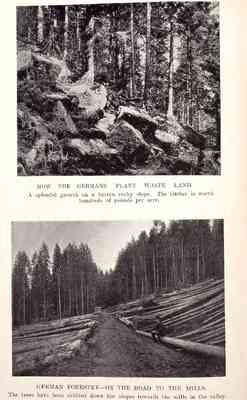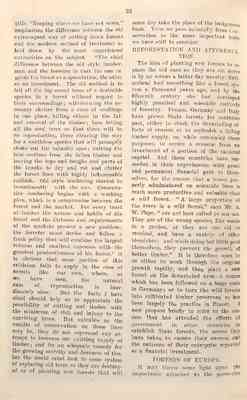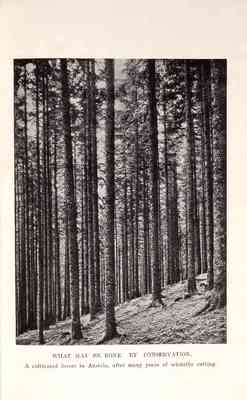Pages
This page is blank
[Illustration]
HOW THE GERMANS PLANT WAST LAND.
A splendid growth on a barren rocky slope. The timber is worth hundreds of pounds per acre.
[Illustration]
GERMAN FORESTRY--ON THE ROAD TO THE MILLS.
The trees have been skidded down the slopes towards the mills in the valley.
21
V.
NEW TREES FOR OLD.
BUT while we have done nothing in the way of coping with fire by systematic means, we have done just as little in the way of making the best and the most of our natural timber resources in other ways. For Forest Conservation, as the secretary of the Kauri Timber Company recently reminded the Timber Commission, means a great deal more than protecting standing trees. To the expert in forestry, conservation means tending the forest, planting new trees to replace the old ones, cutting out only the trees ready for immediate use, and generally making the very best of our natural resources. And I leave it to anyone and everyone in the least degree conversant with the methods of timber cutting generally pursued in this country to decide whether they can be termed careful and economical. So far back as 1870, Sir James (then Doctor) Hector, addresing a Select Committee on Colonial Industries, said that the complete destruction of our native bush was most wasteful and unnecessary. "It is not all necessary," said this eminent scientist, "that the forest should be completely removed in the way that it usually is, either for the purpsoes of agricultural settlement, or the obtaining of timber for mills, firewood, and gencing. The thinning out of the forest would be ample in most cases to supply all our wants." No doubt our system of deforestation is just as extravagant as it was forthy years ago in New Zealand; and so far as the rest of the world is concerned there seems to be a general consensus of opinion that careful and scientific methods of timber cutting would make a vast difference to the present position, and the future prospects of the industry. Rudolf Cronau, an authority who has had wide experience of American forests during the past thirty years, tells us in an article on "A Continent Despoiled," in a recent issue of "McClure's Magazine," that the lumbermen waste half of every tree they cut. "One-fourth of the standing timber is left or otherwise lost in logging. The loss in the mill is from onethrid to two-thirds of the timber sawed. The loss in the mill product though seasoning and fitting for use is from oneseventh to one-fourth. Only 320 feet of timber are used for each thousand feet that stood in the forest." This estimate corresponds closely enough with the opinion advanced by D. Bristol, of the United States Forestry Department, who states that at least fifty per cent, if not more, of the average tree as it stands in the forest is wasted befroe reaching the market in the form of timber. In similar terms Mr M. G. Seckendorf, writing on "The Elimination of Waste" in "Munsey's Magazine," has shown that some seventy-five per cent of America's forest products is wasted, and that most of this disastrous loss is due to preventible fires, careless logging, and wasteful mill operations.
THE WASTE OF TIMBER.
In view of these facts, it is not surprising to find that in the countries where some practical attempt is being made to avert the coming timber famine careful regulations are laid down for the cutting out of the State forests. In the American national forests, for example, it is stipulated that all trees cut down must be felled in such a manner as to protect the young growth as far as possible from injury, and that wherever necessary the brush and tops must be piled and burned. But mrely to cut down the best trees in the best way to save the residue from fire is not enough. Mr Julian Helburn, writing in the "American Magazine" on deforestation under the
22
title, "Reaping where we have not sown," emphasises the difference between the old extravagant way of cutting down forests and the modern method of treatment as laid down by the most experienced authorities on the subject. "The chief difference betwen the old style lumberman and the forester is that the one re gards the forst as a speculation, the other as an investment. The old method is to fell all the big sound treets of a desirable species in a forest without regard to their surroundings; withdrawing the necessary shelter from a crop of seedlings in one place, killing others in the fall and removal of the timber; here felling all the seed trees so that there will be no reproduction, there clearing the way for a worthless species that will promptly choke out the valuable ones; cutting the best sections from the fallen timber and leaving the tops and boughs and parts of the trunks to dry and rot and clutter the forest floor with highly inflammable rubbish. Old style lumbering started in incontinently with axe. Conservative lumbering begins with a working plan, which is a compromise between the forest and the market. For every tract of lumber the nature and habits of the forest and thedistance and requirement of the market present a new problem; the forester must devise and follow a fresh policy that will combine the largest returns and smallest expenses with the greatest productiveness of his forest." It is obvious that some portion of this criticism fails to apply in the case of forests like our own, where, as we have seen, the natural rate of reproduction is inordinately slow. But the facts I have cited should help us to appreciate the possibility of cutting out timber with the minimum of risk and injury to the surviving trees. But valuable as the results of conservation on these lines may be, they do not represent any attempt to increase our existing supply of timber; and for an adequate remedy for the growing scarcity and dearness of timber the world must look to some system of replacing old trees as they are destroyed or of planing new forest that will some day take the place of the indigenous bush. Thus we pass naturally from Conservation to the most important topic we have still to consider.
REFORESTATION AND AFFORESTATION.
The idea of planign new forests to replace the old ones as they are cut down is by no means a latter-day novelty. Switzerland had something like a forest system a thousand years ago, and by the fifteenth century she had developed highly practical and scientific methods of forestry. France, Germany and Italy have drown State forests for centuries past, either to check the devastating effects of erosion or to replenish a failing timber supply, or, while combining these purposes, to secure a revenue from an investment of a portion of the national capital. And these countries have succeeded in their experiments with great and permanent financial gain to themseleves, for the reason that a forest properly administered on scientific lines is much more productive and valuable than a wild forest. "A large proportion of the trees in a wild forest," says Mr. A. W. Page, "are not best suited to our use. They are of the wrong species like weeds in a garden, or they are too old or crooked, and have a variety of toher blemishes; and while doing but little good themselves, they prevent the growth of better timber." It is therefore open to us either to work through the original growth rapidly, and then plant a new forest on the devastated area--a course which has been followed on a large scale in Germany; to to turn the wild forests into cultivated timber preserves, as has been largely the practice in France. I now propose briefly to refer tot he success that has ttended the efforts of government in other countries to establish State forests, the means they have taken to ensure their success, and the outcome of their enterprise regarded as a financial investment.
FOREST OF EUROPE.
It may throw some light upon the importance attached to the possession
[Illustration]
WHAT MAY BE DONE BY CONSERVATION.
A cultivated forest in, after many years of scientific cutting.




